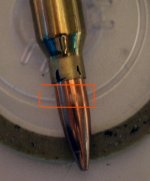G
Gina1
Guest
OK guys, this one has me scratching my head.
Here's the problem I've got and any advice, recommendations or explanations would be greatly appreciated.
I've got a Savage 12FCV .223 and have been reloading for about a year now. I'm not sure this problem was always present or I've just become more attuned to the idiosyncrasies of hand loading.
When reloading new brass, the round will fit into the chamber with no effort, and if unfired can be ejected, with no problems or effort.
On the other hand, using fire formed brass, there is a small effort to close the bolt, and it is difficult to pull the bolt back and remove an unfired round. This happen whether using an FL die or a necking die.
Both new brass and fire formed cases, are set to the same specs. Case trimmed to length, cases are FL re-sized, so head space is the same. OCL is the same, using the same type of bullet. Bullet depth is the same.
In looking at an unfired, fire formed reload after it is removed from the chamber, a scuff mark can be seen on the bullet. The orientation of the scuff mark is always on the bottom left of the bullet.
The picture I've attached is not the best, but it does show the scuff mark.
So what's going on ?? Is something wrong with the rifle or am I doing something wrong. ?
Is the chamber out of alignment so that when the brass is fire formed, it now out of alignment?
So what advice do you have...?? Any and all help will be appreciated
Much thanks
Here's the problem I've got and any advice, recommendations or explanations would be greatly appreciated.
I've got a Savage 12FCV .223 and have been reloading for about a year now. I'm not sure this problem was always present or I've just become more attuned to the idiosyncrasies of hand loading.
When reloading new brass, the round will fit into the chamber with no effort, and if unfired can be ejected, with no problems or effort.
On the other hand, using fire formed brass, there is a small effort to close the bolt, and it is difficult to pull the bolt back and remove an unfired round. This happen whether using an FL die or a necking die.
Both new brass and fire formed cases, are set to the same specs. Case trimmed to length, cases are FL re-sized, so head space is the same. OCL is the same, using the same type of bullet. Bullet depth is the same.
In looking at an unfired, fire formed reload after it is removed from the chamber, a scuff mark can be seen on the bullet. The orientation of the scuff mark is always on the bottom left of the bullet.
The picture I've attached is not the best, but it does show the scuff mark.
So what's going on ?? Is something wrong with the rifle or am I doing something wrong. ?
Is the chamber out of alignment so that when the brass is fire formed, it now out of alignment?
So what advice do you have...?? Any and all help will be appreciated
Much thanks


